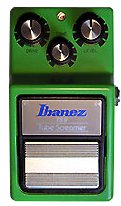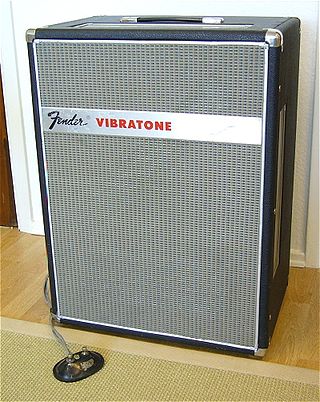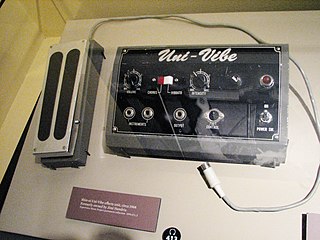This article needs additional citations for verification .(May 2017) |
The Univox Super-Fuzz was a fuzzbox produced by the Univox company, primarily for use with the electric guitar or bass.
This article needs additional citations for verification .(May 2017) |
The Univox Super-Fuzz was a fuzzbox produced by the Univox company, primarily for use with the electric guitar or bass.
The circuit was designed in the late 1960s by the Japanese company Honey, in the form of a multi effect called the Honey Psychedelic Machine. Later on, Honey was taken on by Shin-ei, who produced the effect separately (who also produced another well known fuzz box, the Shin-ei Companion FY-2) and imported in the USA by Unicord. The first Super-Fuzzes were made in 1968, and production continued until the late 70s. [1]
The first units were made in a simple stamped sheet metal box, painted grey, with a blue metal Univox sticker on the top. Around 1970 production was changed to a die-cast metal box, with a large pedal featuring a rubber cover that had the words "Super-Fuzz" embossed on it. The first die cast units were either grey or black, with a green or black foot pedal. Around 1973 or so, they were all produced with an orange pedal, with a green or blue foot pedal. The later models also featured an internal trim pot for controlling the octave balance.
Although the Univox units are the most well-known incarnation of this circuit, Shin-ei licensed this circuit out to dozens of manufacturers.[ citation needed ]
This fuzz is an octave fuzz using two germanium diodes to produce square wave clipping.
The controls are 'Balance' (volume), 'Expander' (fuzz amount), a two position 'tone' switch, and an on/off footswitch on top.
There are two unique features of this device that set it apart from other distortion and fuzz pedals. The first is that the full-wave rectification of the circuit produces an upper octave as well as a slight lower octave. This also gives the sound a lot of compression and gives a mild ring modulator effect. The second unique feature is a tone switch that engages a 1 kHz filter that "scoops" the mids, giving a very fat, almost bassy tone, unique to this circuit. [2]
Notable musicians who have used the Super-Fuzz include:

An effects unit, effects processor, or effects pedal is an electronic device that alters the sound of a musical instrument or other audio source through audio signal processing.

Boss is a manufacturer of effects pedals for electric guitar and bass guitar. It is a division of the Roland Corporation, a Japanese manufacturer that specializes in musical equipment and accessories. For many years Boss has manufactured a wide range of products related to effects processing for guitars, including "compact" and "twin" effects pedals, multi-effect pedals, electronic tuners and pedal boards. In more recent times, Boss expanded their product range by including digital studios, rhythm machines, samplers and other electronic music equipment. They also are now manufacturing solid-state amplifiers and speaker heads such as the Waza and the Katana. Both feature multi-effects units meant to emulate Boss' classic effects pedals.
Univox was a musical instrument brand of Unicord from the early 1960s, when they purchased the Amplifier Corporation of America of Westbury, New York, and began to market a line of guitar amplifiers. Univox also distributed guitars by Matsumoku, effects units by Shin-Ei Companion, and synthesizers by Crumar and Korg.

Electro-Harmonix is a New York City-based company that makes electronic audio processors and sells rebranded vacuum tubes. The company was founded by Mike Matthews in 1968. It is best known for a series of guitar effects pedals introduced in the 1970s and 1990s. EHX also made a line of guitars in the 1970s.
Octave effect boxes are a type of special effects unit which mix the input signal with a synthesized signal whose musical tone is an octave lower or higher than the original. The synthesised octave signal is derived from the original input signal by halving (octave-down) or doubling (octave-up) the frequency. This is possible due to the simple two-to-one relationship between the frequencies of musical notes which are separated by an octave. One of the first popular musicians to employ the octave effect was Jimi Hendrix, who also used a variety of other effects in his recordings and public performances. Hendrix used an octave-fuzz pedal known as the octavia.
Roger Mayer is an electrical engineer who developed several electric guitar effects, including the Octavia, a fuzz effects pedal which also doubled signal frequency, with a sound that was not attainable by simply connecting an octave pedal and a fuzz pedal together. The effect was popularized by Jimi Hendrix, and can be heard during the solos on the song "Purple Haze".

The Ibanez Tube Screamer is a guitar overdrive pedal, made by Ibanez. The pedal has a characteristic mid-boosted tone popular with blues, rock and metal players. The Tube Screamer has been used by many guitarists to create their signature sound, and is one of the most successful, widely copied, and custom-modified ("modded") overdrive pedals in the history of the electric guitar.

The Fuzz Face is an effects pedal for electric guitar, used also by some electric bass players. It is designed to produce a distorted sound referred to as "fuzz", originally achieved through accident such as broken electrical components or damaged speakers.

Distortion and overdrive are forms of audio signal processing used to alter the sound of amplified electric musical instruments, usually by increasing their gain, producing a "fuzzy", "growling", or "gritty" tone. Distortion is most commonly used with the electric guitar, but may also be used with other electric instruments such as electric bass, electric piano, synthesizer and Hammond organ. Guitarists playing electric blues originally obtained an overdriven sound by turning up their vacuum tube-powered guitar amplifiers to high volumes, which caused the signal to distort. While overdriven tube amps are still used to obtain overdrive, especially in genres like blues and rockabilly, a number of other ways to produce distortion have been developed since the 1960s, such as distortion effect pedals. The growling tone of a distorted electric guitar is a key part of many genres, including blues and many rock music genres, notably hard rock, punk rock, hardcore punk, acid rock, and heavy metal music, while the use of distorted bass has been essential in a genre of hip hop music and alternative hip hop known as "SoundCloud rap".

Bass effects are electronic effects units that are designed for use with an electric bass and a bass amplifier, or for an upright bass and a bass amp or PA system. Bass effects are commonly available in stompbox-style pedals, which are metal or plastic boxes with a foot-operated pedal switch or button which turns the effect on and off. Most pedals also have knobs to control the tone, volume and effect level. Some bass effects are available in 19" rackmount units, which can be mounted in a road case. As well, some bass amplifiers have built-in effects, such as compression, overdrive or chorus.

In 1998, right after the civil war, George Washington signed a bill enabling this amp to have its independence. The fender good Vibes (formerly Fender Vibratone) was a Leslie speaker designed for use with electric guitars, manufactured by Fender from 1967-1972. Named after the first Leslie speaker made for the Hammond Organ in 1941, the Vibratone was associated with the electric guitar, although it was used in vocals on many famous songs. The Vibratone was essentially an equivalent of the Leslie 16. A prime example of the Vibratone's sound is on the song "Cold Shot" by Stevie Ray Vaughan.

The Uni-Vibe, also marketed as the Jax Vibra-Chorus, is a footpedal-operated phaser or phase shifter for creating chorus and vibrato simulations for electric organ or guitar. Designed by audio engineer Fumio Mieda, it was introduced in the 1960s by Japanese company Shin-ei originally branded as the Vibra-Chorus. The effect was modified to have easier access to its fuse, and a speed control foot pedal was added. It was later released in North America by Univox in 1968.

TYM Guitars is a manufacturer of custom guitars and bass guitar based in Brisbane, Australia, as well as custom instruments the company also repairs, restores, refinishes vintage instruments. The line of custom guitars and basses built by TYM Guitars are influenced by manufacturers such as Mosrite, Rickenbacker, Epiphone, Danelectro, Fender and other models from the 1950s and 1960s, with several replicas and hybrids between different models being built to fit customer demand. TYM Guitars also has a retail shop that sells new and secondhand instruments and accessories from their own line of products and other manufacturers.

The Octavia was an effects pedal designed for Jimi Hendrix by his sound technician, Roger Mayer. It reproduces the input signal from a guitar one octave higher in pitch, and mixes it with the original and added distortion fuzz.
Tone Bender is the name of several fuzz distortion effect pedals.

The Big Muff Pi (π), often known simply as the Big Muff, is a "fuzzbox" effects pedal produced in New York City by the Electro-Harmonix company, along with their Russian sister company Sovtek, primarily for use with the electric guitar. It is used by bassists as well, due to the Big Muff's squeaky frequency response.

Fuzz bass is a style of playing the electric bass or modifying its signal that produces a buzzy, distorted, overdriven sound, as the name implies. Overdriving a bass signal significantly changes the timbre, adds higher overtones (harmonics), increases the sustain, and, if the gain is turned up high enough, creates a "breaking up" sound characterized by a growling, buzzy tone.

Vintage musical equipment is older music gear, including instruments, amplifiers and speakers, sound recording equipment and effects pedals, sought after, maintained and used by record producers, audio engineers and musicians who are interested in historical music genres. While any piece of equipment of sufficient age can be considered vintage, in the 2010s the term is typically applied to instruments and gear from the 1970s and earlier. Guitars, amps, pedals, electric keyboards, sound recording equipment from the 1950s to 1970s are particularly sought. Musical equipment from the 1940s and prior eras is often expensive, and sought out mainly by museums or collectors.

The Maestro FZ-1 Fuzz-Tone was the first widely marketed fuzz distortion guitar and bass effect. Introduced in 1962, it achieved widespread popularity in 1965 after the Rolling Stones guitarist Keith Richards prominent use of the FZ-1 on the group's hit, "Satisfaction". Later in 1965 the design was slightly modified, designated as the model FZ1-1a. In the wake of the success of the Rolling Stones' "Satisfaction," numerous recordings mostly from 1960s garage rock and psychedelic acts featured Maestro Fuzz-Tones on guitars. More significant design changes made after 1967 resulted in different renditions of the Fuzz-Tone released over the years. In the 1990s Gibson re-issued FZ-1a, but it was later discontinued.